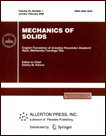 | | Mechanics of Solids
A Journal of Russian Academy of Sciences | | Founded
in January 1966
Issued 6 times a year
Print ISSN 0025-6544
Online ISSN 1934-7936 |
Archive of Issues
| Total articles in the database: | | 13362 |
| In Russian (╚šÔ. đ└═. ╠ĎĎ): | | 8178
|
| In English (Mech. Solids): | | 5184 |
|
| << Previous article | Volume 59, Issue 5 / 2024 | Next article >> |
| M.D. Umbharatwala, Manmohan Dass Goel, Gaurav Tiwari, and Nikhil Andraskar, "Numerical Study on Performance Evaluation of Alumina 99.6%, Kevlar«, Aluminium Composite Armour Panels," Mech. Solids. 59 (5), 3068-3096 (2024) |
| Year |
2024 |
Volume |
59 |
Number |
5 |
Pages |
3068-3096 |
| DOI |
10.1134/S0025654424605172 |
| Title |
Numerical Study on Performance Evaluation of Alumina 99.6%, Kevlar«, Aluminium Composite Armour Panels |
| Author(s) |
M.D. Umbharatwala (Department of Applied Mechanics, Visvesvaraya National Institute of Technology, Nagpur, Maharashtra, 440010 India)
Manmohan Dass Goel (Department of Applied Mechanics, Visvesvaraya National Institute of Technology, Nagpur, Maharashtra, 440010 India, mdgoel@apm.vnit.ac.in)
Gaurav Tiwari (Department of Mechanical Engineering, Visvesvaraya National Institute of Technology, Nagpur, Maharashtra, 440010 India)
Nikhil Andraskar (Department of Mechanical Engineering, Visvesvaraya National Institute of Technology, Nagpur, Maharashtra, 440010 India) |
| Abstract |
The current study is focused on evaluating the effectiveness of composite armour made from ceramic, fabric and metal, employing various configurations. Additionally, it incorporates Technique for Order of Preference by Similarity to Ideal Solution (TOPSIS) analysis to compare the performance of different configurations of composite armour plates having 20 mm thickness against high-velocity hard steel core armour-piercing projectiles, particularly for vehicle armour applications. The ceramic component of the armour comprises hardened alumina (99.6%), Kevlar« fabric-based fibre-matrix composites, and an epoxy blend reinforced with carbon nanotubes (CNTs). The design of the armour prioritized maintaining a ceramic tile as the frontal impact surface, complemented by an aluminium (Al 2024-T3) plate and a CNT-reinforced Kevlar« composite on the rear. The armour was engineered as a functionally graded composite material with varying levels of hardness and toughness. To ensure equitable comparison across armour plates, the total thickness of the composite was consistently set at 20 mm, and its performance was assessed under two distinct impact velocities: 725 and 550 m/s. A multi-criterion based decision-making (MCDM) approach was employed to comprehensively analyse the armourĺs performance across multiple parameters. The study shows that the stacking sequence of the materials significantly alters the ballistic resistance of composite panel despite possessing similar arial density. Also, Certain configurations outperforms others despite having lesser arial density. |
| Keywords |
multi-criteria method, decision making, ceramic composite, fabric composite, functionally graded armour, ballistic impact, TOPSIS |
| Received |
29 August 2024 | Revised |
08 October 2024 | Accepted |
14 October 2024 |
| Link to Fulltext |
|
| << Previous article | Volume 59, Issue 5 / 2024 | Next article >> |
|
 If you find a misprint on a webpage, please help us correct it promptly - just highlight and press Ctrl+Enter If you find a misprint on a webpage, please help us correct it promptly - just highlight and press Ctrl+Enter
|
|

 Russian
Russian  English
English